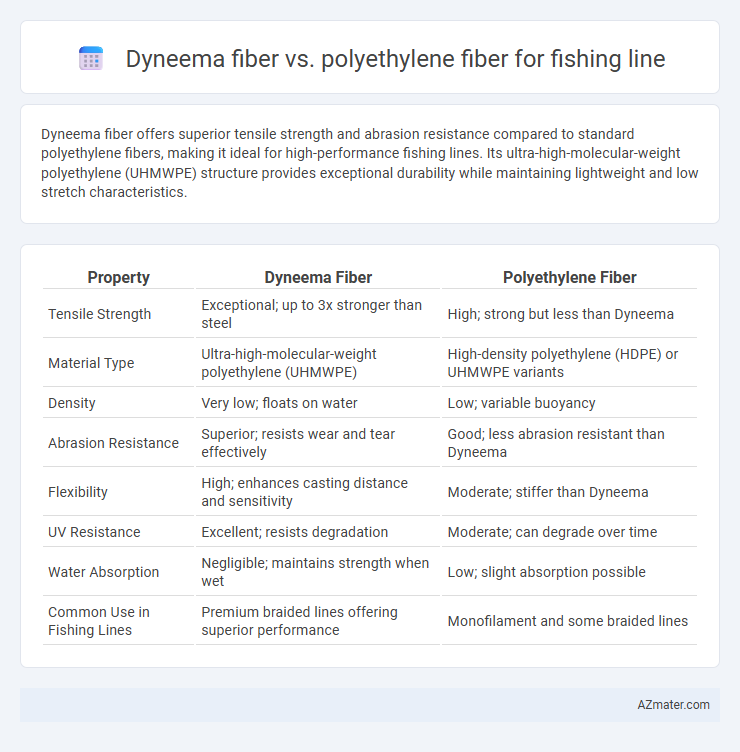Dyneema fiber offers superior tensile strength and abrasion resistance compared to standard polyethylene fibers, making it ideal for high-performance fishing lines. Its ultra-high-molecular-weight polyethylene (UHMWPE) structure provides exceptional durability while maintaining lightweight and low stretch characteristics.
Table of Comparison
| Property | Dyneema Fiber | Polyethylene Fiber |
|---|---|---|
| Tensile Strength | Exceptional; up to 3x stronger than steel | High; strong but less than Dyneema |
| Material Type | Ultra-high-molecular-weight polyethylene (UHMWPE) | High-density polyethylene (HDPE) or UHMWPE variants |
| Density | Very low; floats on water | Low; variable buoyancy |
| Abrasion Resistance | Superior; resists wear and tear effectively | Good; less abrasion resistant than Dyneema |
| Flexibility | High; enhances casting distance and sensitivity | Moderate; stiffer than Dyneema |
| UV Resistance | Excellent; resists degradation | Moderate; can degrade over time |
| Water Absorption | Negligible; maintains strength when wet | Low; slight absorption possible |
| Common Use in Fishing Lines | Premium braided lines offering superior performance | Monofilament and some braided lines |
Introduction to Dyneema and Polyethylene Fibers
Dyneema fiber is an ultra-high-molecular-weight polyethylene (UHMWPE) known for its exceptional strength-to-weight ratio, making it a top choice for fishing lines requiring durability and sensitivity. Polyethylene fibers, including Dyneema and Spectra, are characterized by high tensile strength, low stretch, and excellent abrasion resistance, essential for long-lasting, high-performance fishing applications. The unique molecular structure of Dyneema provides superior cut resistance and floatation properties compared to standard polyethylene fibers, enhancing angler control and reliability.
Composition and Manufacturing Processes
Dyneema fiber is an ultra-high-molecular-weight polyethylene (UHMWPE) known for its exceptional strength-to-weight ratio, produced through a gel-spinning process that aligns polymer chains to enhance durability and tensile strength. In contrast, standard polyethylene fibers used in fishing lines are typically low- to high-density polyethylene made via extrusion methods, resulting in lower strength and abrasion resistance. The advanced gel-spinning technique in Dyneema manufacturing significantly improves molecular orientation and fiber performance compared to conventional polyethylene fibers.
Strength and Durability Comparison
Dyneema fiber offers superior tensile strength and abrasion resistance compared to traditional polyethylene fibers, making it highly effective for heavy-duty fishing lines. Its ultra-high-molecular-weight polyethylene structure grants enhanced durability and minimal stretch, improving sensitivity and hook-setting performance. Polyethylene fibers, while strong, generally exhibit lower strength-to-weight ratios and degrade faster under prolonged UV exposure, reducing overall lifespan in fishing applications.
Stretch and Sensitivity Differences
Dyneema fiber offers significantly lower stretch compared to conventional polyethylene fibers, providing enhanced sensitivity crucial for detecting subtle bites in fishing. Its ultra-high-molecular-weight polyethylene (UHMWPE) composition allows minimal elongation under tension, delivering precise feedback and improved hook-setting performance. In contrast, standard polyethylene fibers exhibit higher stretch, which can dampen sensitivity and delay response time during fishing.
Abrasion Resistance: Dyneema vs Polyethylene
Dyneema fiber exhibits superior abrasion resistance compared to standard polyethylene fibers, making it a preferred choice for high-performance fishing lines exposed to rough underwater structures and sharp objects. Its ultra-high molecular weight structure provides exceptional durability while maintaining lightweight and high tensile strength, essential for anglers targeting large, aggressive fish. Polyethylene fibers, although strong, tend to wear faster in abrasive environments, reducing line longevity and increasing the risk of breakage during intense fishing conditions.
Water Absorption and Performance in Wet Conditions
Dyneema fiber exhibits near-zero water absorption, maintaining consistent strength and flexibility in wet conditions, making it ideal for fishing lines exposed to prolonged water exposure. Polyethylene fiber, while lightweight and strong, tends to absorb more water, which can lead to slight swelling and diminished performance over time. The superior water resistance of Dyneema enhances casting distance and knot strength in aquatic environments, ensuring reliable performance during fishing activities.
Knot Strength and Handling
Dyneema fiber offers superior knot strength compared to traditional polyethylene fibers due to its high tensile strength and low stretch properties, making it less prone to knot slippage and breakage under tension. Its smooth surface enhances line handling, providing better casting distance and reduced abrasion resistance, crucial for fishing in challenging environments. Polyethylene fibers, while lighter and more buoyant, often require more careful knotting techniques to maintain strength and can lack the same level of durability and ease of handling as Dyneema-based lines.
Diameter and Weight Considerations
Dyneema fiber offers superior strength-to-weight ratio compared to standard polyethylene fibers, resulting in thinner diameters without compromising tensile strength, which allows for less water resistance and improved casting distance in fishing lines. Polyethylene fiber, though slightly heavier and with larger diameter at equivalent strength levels, remains cost-effective and provides excellent abrasion resistance, making it suitable for heavy-duty fishing applications. When choosing between Dyneema and polyethylene fibers for fishing lines, focusing on diameter and weight considerations helps anglers select lines that optimize sensitivity, durability, and handling performance.
Cost and Availability for Anglers
Dyneema fiber fishing lines are generally more expensive due to their advanced high-modulus polyethylene (HMPE) technology, offering exceptional strength-to-weight ratios but limited availability in some regions. Polyethylene fiber lines, such as generic PE blends, tend to be more affordable and widely accessible, making them a popular choice for budget-conscious anglers. Cost-effectiveness and local retail presence often influence the decision between premium Dyneema lines and standard PE alternatives for fishing applications.
Final Verdict: Which Fiber is Best for Fishing Line?
Dyneema fiber outperforms polyethylene fiber in fishing lines due to its superior tensile strength, enhanced abrasion resistance, and lower stretch rates, providing anglers with increased sensitivity and durability. Dyneema's higher strength-to-weight ratio ensures thinner, lighter lines capable of handling larger fish compared to traditional polyethylene lines. For serious fishing applications requiring optimal performance, Dyneema-based lines offer the best balance of strength, durability, and sensitivity.

Infographic: Dyneema fiber vs Polyethylene fiber for Fishing line
 azmater.com
azmater.com